Feng Nan
ToolSandbox: A Stateful, Conversational, Interactive Evaluation Benchmark for LLM Tool Use Capabilities
Aug 08, 2024
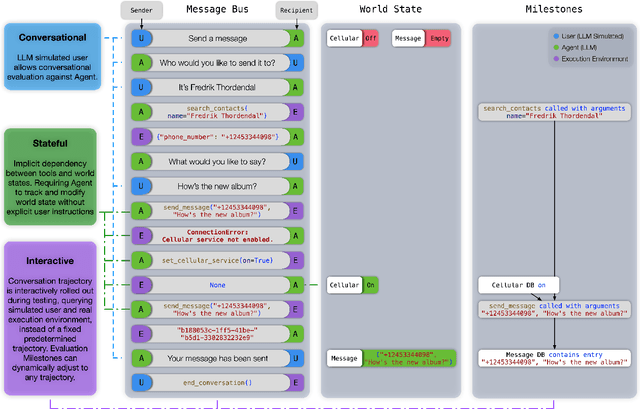
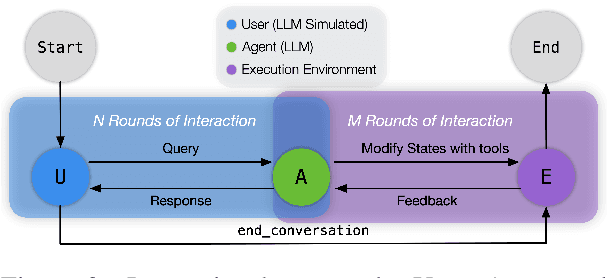
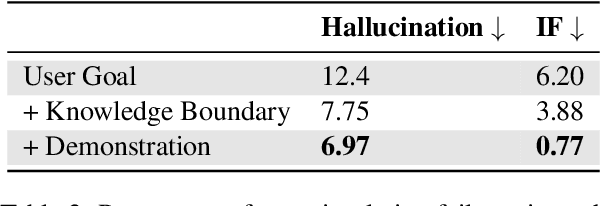
Abstract:Recent large language models (LLMs) advancements sparked a growing research interest in tool assisted LLMs solving real-world challenges, which calls for comprehensive evaluation of tool-use capabilities. While previous works focused on either evaluating over stateless web services (RESTful API), based on a single turn user prompt, or an off-policy dialog trajectory, ToolSandbox includes stateful tool execution, implicit state dependencies between tools, a built-in user simulator supporting on-policy conversational evaluation and a dynamic evaluation strategy for intermediate and final milestones over an arbitrary trajectory. We show that open source and proprietary models have a significant performance gap, and complex tasks like State Dependency, Canonicalization and Insufficient Information defined in ToolSandbox are challenging even the most capable SOTA LLMs, providing brand-new insights into tool-use LLM capabilities. ToolSandbox evaluation framework is released at https://github.com/apple/ToolSandbox
Apple Intelligence Foundation Language Models
Jul 29, 2024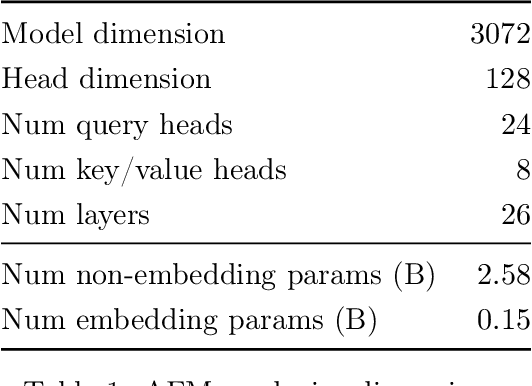
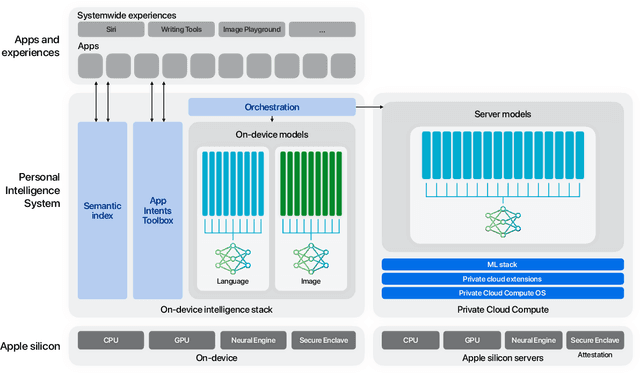

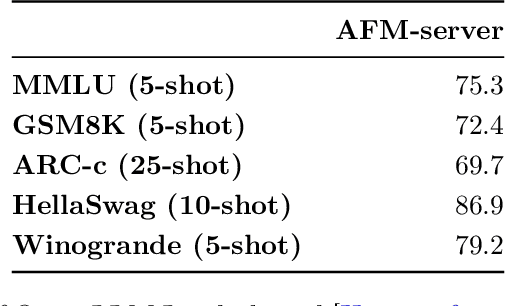
Abstract:We present foundation language models developed to power Apple Intelligence features, including a ~3 billion parameter model designed to run efficiently on devices and a large server-based language model designed for Private Cloud Compute. These models are designed to perform a wide range of tasks efficiently, accurately, and responsibly. This report describes the model architecture, the data used to train the model, the training process, how the models are optimized for inference, and the evaluation results. We highlight our focus on Responsible AI and how the principles are applied throughout the model development.
SWING: Balancing Coverage and Faithfulness for Dialogue Summarization
Jan 25, 2023Abstract:Missing information is a common issue of dialogue summarization where some information in the reference summaries is not covered in the generated summaries. To address this issue, we propose to utilize natural language inference (NLI) models to improve coverage while avoiding introducing factual inconsistencies. Specifically, we use NLI to compute fine-grained training signals to encourage the model to generate content in the reference summaries that have not been covered, as well as to distinguish between factually consistent and inconsistent generated sentences. Experiments on the DialogSum and SAMSum datasets confirm the effectiveness of the proposed approach in balancing coverage and faithfulness, validated with automatic metrics and human evaluations. Additionally, we compute the correlation between commonly used automatic metrics with human judgments in terms of three different dimensions regarding coverage and factual consistency to provide insight into the most suitable metric for evaluating dialogue summaries.
ContraGen: Effective Contrastive Learning For Causal Language Model
Oct 03, 2022



Abstract:Despite exciting progress in large-scale language generation, the expressiveness of its representations is severely limited by the \textit{anisotropy} issue where the hidden representations are distributed into a narrow cone in the vector space. To address this issue, we present ContraGen, a novel contrastive learning framework to improve the representation with better uniformity and discrimination. We assess ContraGen on a wide range of downstream tasks in natural and programming languages. We show that ContraGen can effectively enhance both uniformity and discrimination of the representations and lead to the desired improvement on various language understanding tasks where discriminative representations are crucial for attaining good performance. Specifically, we attain $44\%$ relative improvement on the Semantic Textual Similarity tasks and $34\%$ on Code-to-Code Search tasks. Furthermore, by improving the expressiveness of the representations, ContraGen also boosts the source code generation capability with $9\%$ relative improvement on execution accuracy on the HumanEval benchmark.
Analyzing the Abstractiveness-Factuality Tradeoff With Nonlinear Abstractiveness Constraints
Aug 05, 2021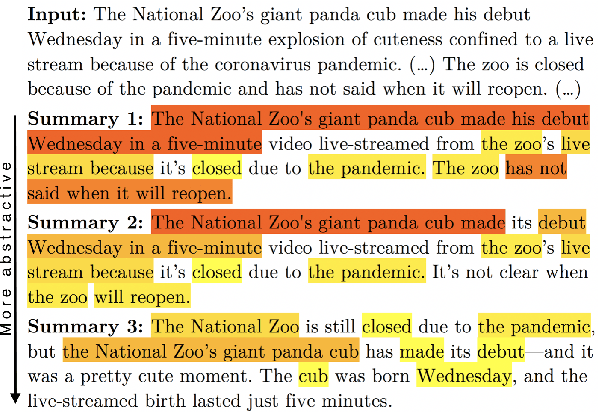
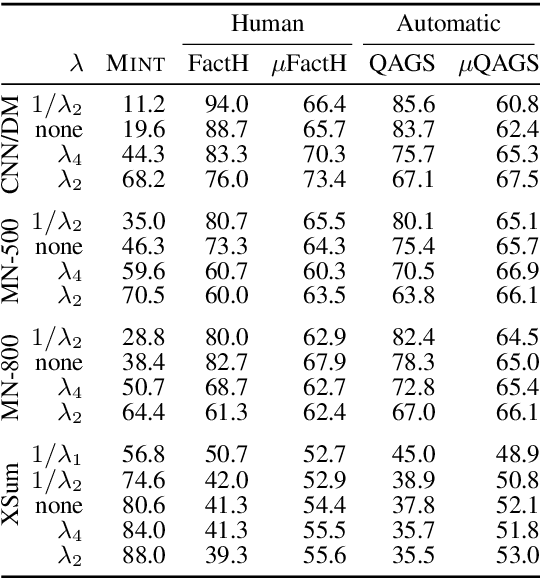
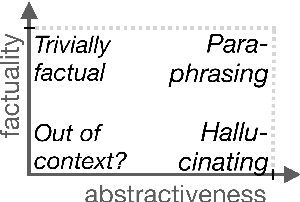
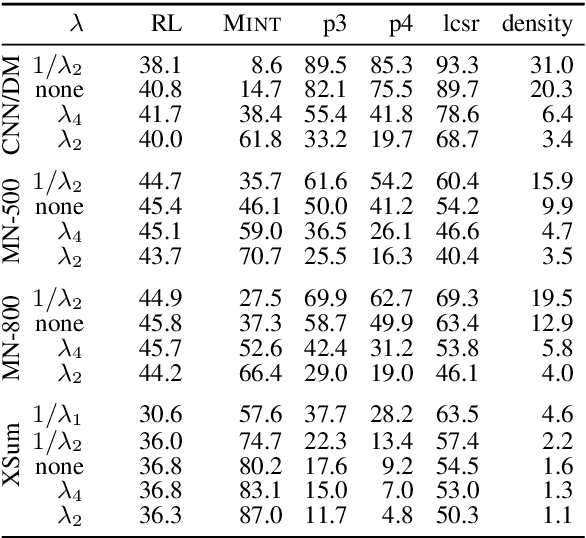
Abstract:We analyze the tradeoff between factuality and abstractiveness of summaries. We introduce abstractiveness constraints to control the degree of abstractiveness at decoding time, and we apply this technique to characterize the abstractiveness-factuality tradeoff across multiple widely-studied datasets, using extensive human evaluations. We train a neural summarization model on each dataset and visualize the rates of change in factuality as we gradually increase abstractiveness using our abstractiveness constraints. We observe that, while factuality generally drops with increased abstractiveness, different datasets lead to different rates of factuality decay. We propose new measures to quantify the tradeoff between factuality and abstractiveness, incl. muQAGS, which balances factuality with abstractiveness. We also quantify this tradeoff in previous works, aiming to establish baselines for the abstractiveness-factuality tradeoff that future publications can compare against.
Improving Factual Consistency of Abstractive Summarization via Question Answering
May 10, 2021



Abstract:A commonly observed problem with the state-of-the art abstractive summarization models is that the generated summaries can be factually inconsistent with the input documents. The fact that automatic summarization may produce plausible-sounding yet inaccurate summaries is a major concern that limits its wide application. In this paper we present an approach to address factual consistency in summarization. We first propose an efficient automatic evaluation metric to measure factual consistency; next, we propose a novel learning algorithm that maximizes the proposed metric during model training. Through extensive experiments, we confirm that our method is effective in improving factual consistency and even overall quality of the summaries, as judged by both automatic metrics and human evaluation.
Towards Clinical Encounter Summarization: Learning to Compose Discharge Summaries from Prior Notes
Apr 27, 2021



Abstract:The records of a clinical encounter can be extensive and complex, thus placing a premium on tools that can extract and summarize relevant information. This paper introduces the task of generating discharge summaries for a clinical encounter. Summaries in this setting need to be faithful, traceable, and scale to multiple long documents, motivating the use of extract-then-abstract summarization cascades. We introduce two new measures, faithfulness and hallucination rate for evaluation in this task, which complement existing measures for fluency and informativeness. Results across seven medical sections and five models show that a summarization architecture that supports traceability yields promising results, and that a sentence-rewriting approach performs consistently on the measure used for faithfulness (faithfulness-adjusted $F_3$) over a diverse range of generated sections.
Supporting Clustering with Contrastive Learning
Mar 24, 2021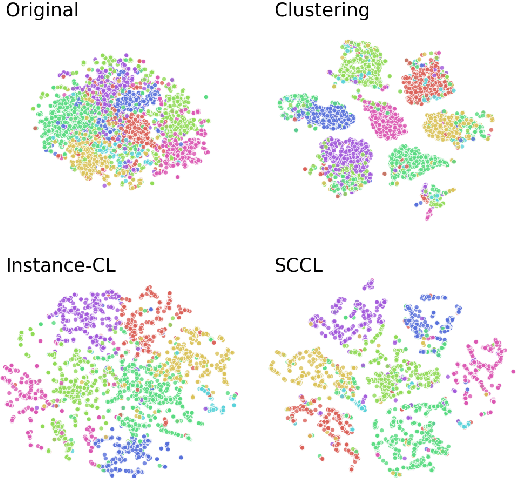
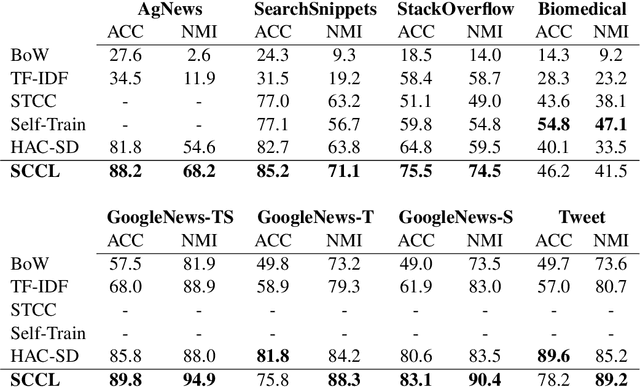

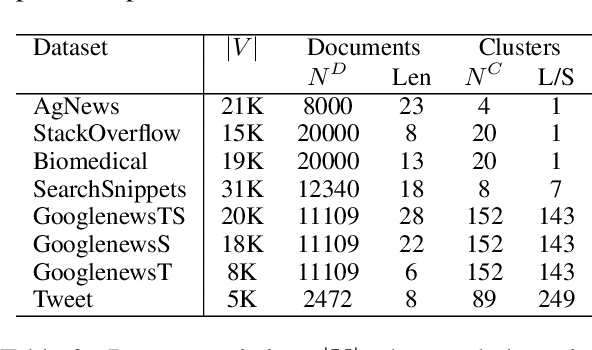
Abstract:Unsupervised clustering aims at discovering the semantic categories of data according to some distance measured in the representation space. However, different categories often overlap with each other in the representation space at the beginning of the learning process, which poses a significant challenge for distance-based clustering in achieving good separation between different categories. To this end, we propose Supporting Clustering with Contrastive Learning (SCCL) -- a novel framework to leverage contrastive learning to promote better separation. We assess the performance of SCCL on short text clustering and show that SCCL significantly advances the state-of-the-art results on most benchmark datasets with 3%-11% improvement on Accuracy and 4%-15% improvement on Normalized Mutual Information. Furthermore, our quantitative analysis demonstrates the effectiveness of SCCL in leveraging the strengths of both bottom-up instance discrimination and top-down clustering to achieve better intra-cluster and inter-cluster distances when evaluated with the ground truth cluster labels
Entity-level Factual Consistency of Abstractive Text Summarization
Feb 18, 2021



Abstract:A key challenge for abstractive summarization is ensuring factual consistency of the generated summary with respect to the original document. For example, state-of-the-art models trained on existing datasets exhibit entity hallucination, generating names of entities that are not present in the source document. We propose a set of new metrics to quantify the entity-level factual consistency of generated summaries and we show that the entity hallucination problem can be alleviated by simply filtering the training data. In addition, we propose a summary-worthy entity classification task to the training process as well as a joint entity and summary generation approach, which yield further improvements in entity level metrics.
Answering Ambiguous Questions through Generative Evidence Fusion and Round-Trip Prediction
Nov 26, 2020



Abstract:In open-domain question answering, questions are highly likely to be ambiguous because users may not know the scope of relevant topics when formulating them. Therefore, a system needs to find every possible interpretation of the question, and propose a set of disambiguated question-answer pairs. In this paper, we present a model that aggregates and combines evidence from multiple passages to generate question-answer pairs. Particularly, our model reads a large number of passages to find as many interpretations as possible. In addition, we propose a novel round-trip prediction approach to generate additional interpretations that our model fails to find in the first pass, and then verify and filter out the incorrect question-answer pairs to arrive at the final disambiguated output. On the recently introduced AmbigQA open-domain question answering dataset, our model, named Refuel, achieves a new state-of-the-art, outperforming the previous best model by a large margin. We also conduct comprehensive analyses to validate the effectiveness of our proposed round-trip prediction.
 Add to Chrome
Add to Chrome Add to Firefox
Add to Firefox Add to Edge
Add to Edge